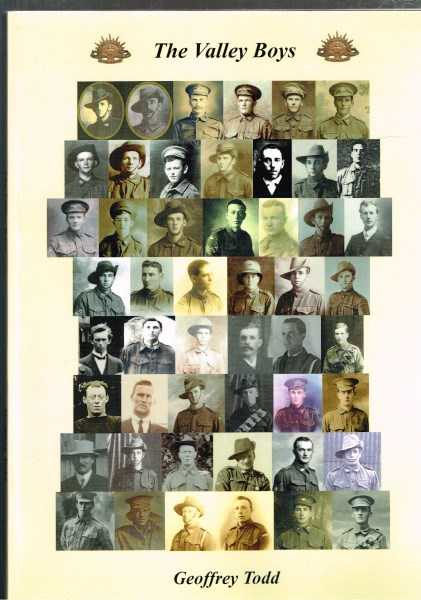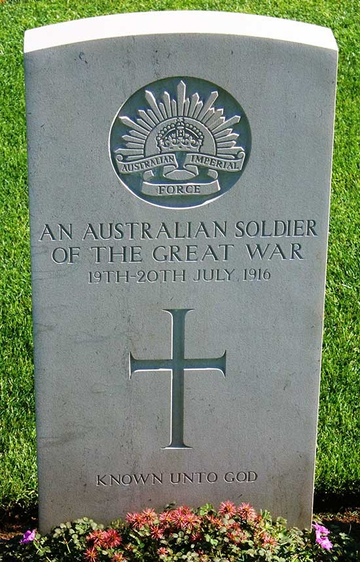
Benjamin RICHARDSON
Eyes blue, Hair fair, Complexion fair
Benjamin Arthur Richardson No. 4581
DNA search Can you help?
Do you know anything of Ben’s relatives here in Australia? – in Canada? - or in England?
Benjamin Richardson is one of the soldiers still missing, named by the Germans as having died in their lines and they returned his ID disc with documentation. We refer to this as the German Death List (GDL).
As of 2024 2022, 180 of the 250 in the Fromelles mass grave have been identified through family DNA.
We are still searching for suitable Y DNA for Ben from his Dad’s side of the family. We are looking at connections to Richardson grandparents and great-grandparents who came from the village of Blaxhall in Suffolk. We believe, however, that four of his brothers migrated to Canada so donors may possibly be in Canada or England – or even elsewhere. See the DNA box at the end of the story.
In preparing this story, we are indebted to Geoff Todd of Kangaroo Valley for his permission to use his 2012 WW1 History – The Valley Boys: The Service and Sacrifice of Men from the NSW Township of Kangaroo Valley in the Great War 1914-18.
The Richardson family in Suffolk
Emma (nee Farrow) 1863-1932 and Benjamin Richardson, snr, 1863-1949 had nine children between 1889 and 1907 - George, Charles, William, Benjamin, Jane, Arthur, Thomas, Robert and Elizabeth.
The Richardsons were a well-established family in Blaxhall, Suffolk, with both father and grandfather also named Benjamin and born in Blaxhall. Benjamin, jnr, migrated to Australia in 1914 while George, William, Arthur and Robert, found their way to Canada.
Benjamin, aged 21, landed in Sydney on the P&O ship Geelong on 5 February 1914. Back home in Suffolk, Benjamin was a farm horseman and so took work in Kangaroo Valley, New South Wales as a farm labourer before enlisting on 3 August 1915, the same day as many other Kangaroo Valley boys. One of those young men was a fellow “back homer” 4532 Frederick John Land from Dulverton in Somerset. Fred had also tried to enlist that day but failed the medical; he succeeded three weeks later. Eventually, he was to join Benjamin in the 54th Battalion. You can read more about the sporting soldiers from the Valley here https://fromelles.info/the-search-for-the-missing/the-sportsmen-of-fromelles/
To the 54th in Egypt and then to France
Benjamin embarked with the 13th Battalion for Europe on the HMAT A70 Ballarat on 16 February 1916 but was later re-assigned with 178 other reinforcements to the 54th Battalion (B Coy) while in the training camp in Egypt. By mid-April 1916, the new battalion was brought to strength with 32 officers and 1087 other ranks.
After concentrating at Tel-el-Kebir, the 54th Battalion undertook a period of intense training followed by a long and arduous desert march to Moascar. Here it took up defensive duties along the Suez Canal in anticipation of a Turkish attack.
The boredom of this garrison duty was broken on 19 June when orders were received to entrain to Alexandria for movement to Europe. Benjamin boarded the HMT Caledonian the next day and sailed from Alexandria on 22 June, coaling at Malta before arriving in Marseilles France on 29 June.
To the trenches
Everything now happened in a hurry. The battalion moved away from Marseilles to Hazebrouck as the British forces launched their Somme offensive to the north. The immediate and catastrophic failure of this Somme campaign was to hasten the movement of many untried Australian battalions into the fight, with appalling consequences.
To the north of the Somme, after a week of training and fit-out, the 54th was marched into the “quiet” trenches of Fromelles with their commanding officer recording that:
“.. the health and spirit of the men is good.”
These men were eager for a crack at the Germans and were to know by 17 July that their move into the trenches here was for the purpose of developing an attack on the German lines. However, enthusiasm and raw courage alone were to be no substitute for experience and diligent preparation.
They were less than three weeks on the Western Front with no more battle experience than the march into the front line. The beast of war was ever hungry.
At 5.50pm on the afternoon of 19th July, the Battalion rose to lead a diversionary attack on Fromelles. The battle was a hasty attempt to stop the Germans from moving troops away from here to the Somme. Preparations for this attack were consequently rushed, the strength of the enemy’s defences was underestimated, and the attack was to take place across 400 yards of open ground into the afternoon sun. Fatefully, the enemy also appears to have had prior warning of the attack - and much of the intended battle plan - thanks to poor security and civilian informants.
The Germans thought the attack to be: “ … operationally and tactically senseless.”
The Australians knew it to be “… the worst 24 hours in Australia’s entire history”.

The 54th Battalion managed to occupy the German trenches for a short period having reached the second line of trenches in quick time. However, they were soon devoid of flanking support due to the failure of the adjacent British units to advance and were then subjected to intense machinegun fire and fierce counterattacks. This enabled the Germans to re-occupy their first line trenches behind the Australians.
The order to withdraw was given around 5.40am and by 9am the remnants of the 53rd, 54th and 55th Battalions had returned to their original lines. The losses to the 54th were staggering - 3 officers and 70 other ranks killed, 11 officers and 277 other ranks wounded, 4 officers and 169 other ranks missing, including Private Ben Richardson. The effective strength of the 54th was reduced by 62% in less than two days.
Now known as the Battle of Fromelles, this bloody initiation cost the AIF 5th Division 5,533 officers and men in 27 hours. Over 2,000 Australians lay dead. The mission was an abject failure, ill-conceived and poorly executed, and a testament to the incompetence of the British Military High Command. This venture caused the Australian troops ever after to distrust the British.
The campaign was later described as “… the worst 24 hours in Australia’s entire history”, but was later subsumed by British reporting as a useful “raid”.
Ben Richardson was killed on the afternoon or evening of 19 July. No record of the manner or circumstance of his death was possible due to the heavy losses. All the 54th Battalion officers were either killed or wounded, and those few remaining had no recollection of his passing.
In one of the supreme contradictions of the brutality of this conflict the opposing armies often recorded and communicated knowledge of the dead of their foe. Accordingly, the Germans recovered Ben’s body and his name appeared on the German Death List (below) on 4 November 1916.
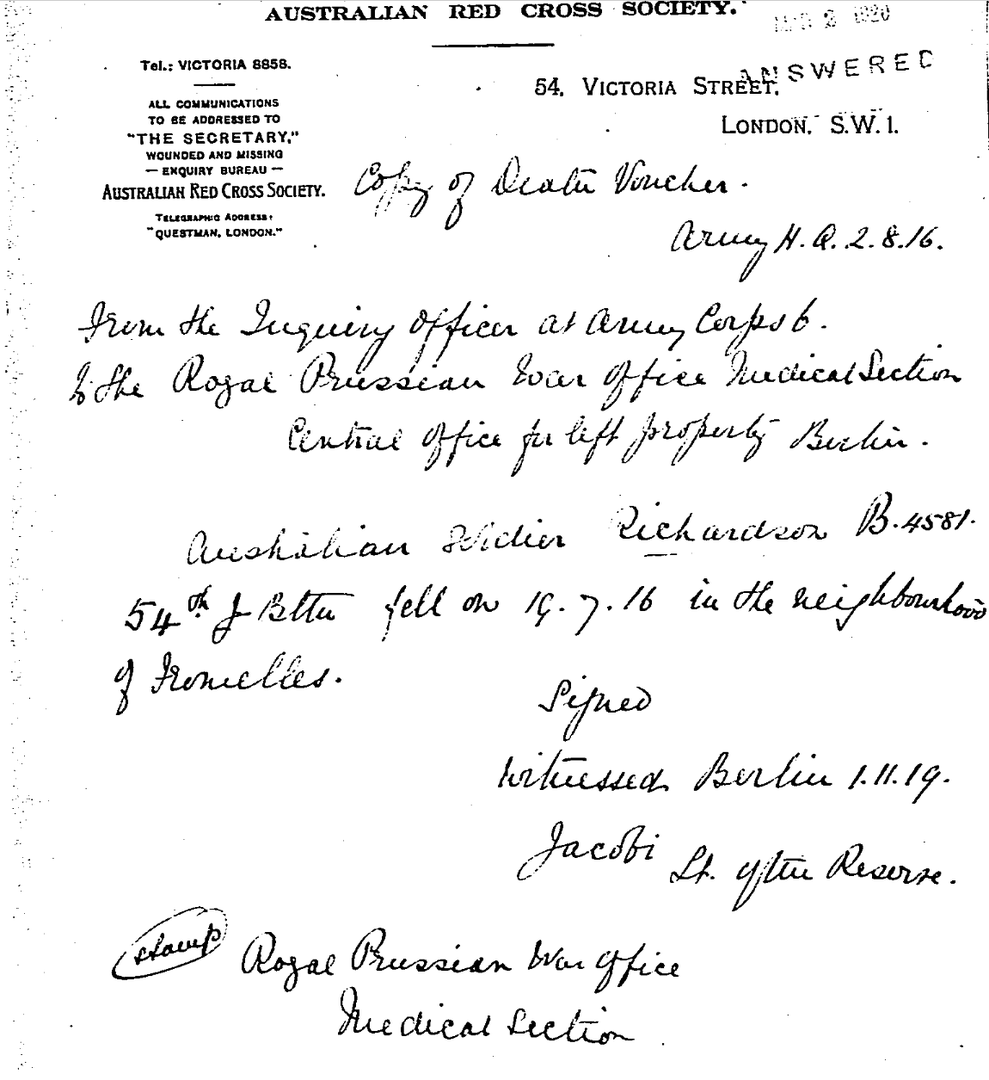
German Major Julius Ritter von Braun had commanded the German forces opposing the Australians and after the battle ordered the excavation of mass graves behind Pheasant Wood for up to 400 British and Australian soldiers. While the souveniring of personal belongings from a battlefield is as old as war itself, on Von Braun’s specific orders the bodies to be interred were individually stripped of identity tags and personal effects by an assigned NCO medical officer and team. These effects were then to be properly collected, tagged and recorded. Von Braun would record:
The misappropriation of the most insignificant item of property from a body (German or English) constitutes robbery of the dead and will be severely punished.
Consequently, Ben’s identity disc was returned to his family at Blaxhall on 11 May 1917. His father Benjamin had written on 8 March 1917 desperately seeking any news of his son’s disappearance. None was forthcoming.
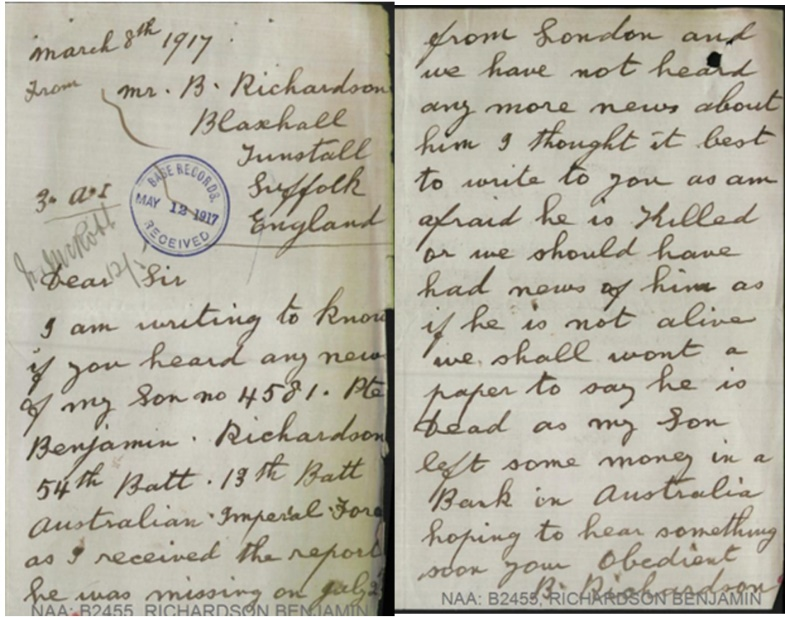
Ben Senior later received his son’s medals and his Memorial Plaque, or “Dead Man’s Penny”. This brass plaque was later found in the garden shed of a house in Suffolk England in the 1980’s but its significance was not identified until 2010.
Memorials in France, England and Australia
With no known grave, efforts to honour Private Benjamin Richardson’s service include the inscribing of his name on significant war memorials.
In France, Ben’s name appears under the 54th Battalion losses on the V.C. Corner Australian Cemetery and Memorial at Fromelles. After the war remains from No Mans Land were gathered and interred in a mass grave, creating the VC Corner Cemetery. There are no headstones to individual soldiers, simply a stone wall inscribed with the names of the 1299 Australians who died in the battle and have no known grave.
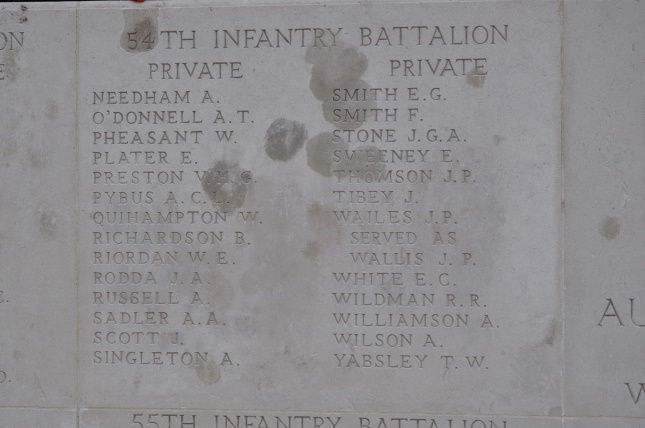
In England, Ben’s name appears on the roll of honour in the medieval St Peter’s church in Blaxhall, Suffolk. The roll also includes his older brother, George, who was killed in France in May 1917 while serving with the Canadian army.
In Australia, Ben’s name is included on the Kangaroo Valley War Memorial in the Shoalhaven region of the NSW south coast and on the Australian War Memorial (panel 159) in Canberra.

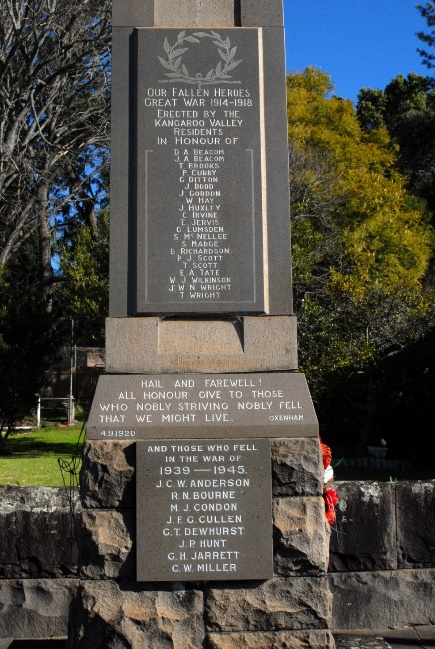
But Ben’s name appearing on the German death list gives rise to the possibility that he may be buried at the Pheasant Wood site. It is only through research and suitable DNA donors that this can be determined.
Searching for DNA
In seeking suitable DNA donors, we look first to the soldier’s immediate family. Benjamin was one of nine siblings, at least three of whom had connections with Canada.
George (1888-1917) left for Canada not long after the 1911 census; he was not with the family on census night (2 April) but boarding at another Blaxhall residence. He wound up farming in Campbellford, Ontario and, as a single man, enlisted in the Canadian Army in May 1916. Just under a year later in May 1917, George was killed in action in France whilst serving with the Central Ontario Regiment, 19th Battalion. He is buried at La Targette British Cemetery in France and is commemorated in the Canadian First World War Book of Remembrance (page 315), the Blaxhall War Memorial and Suffolk County Council Roll of Honour.
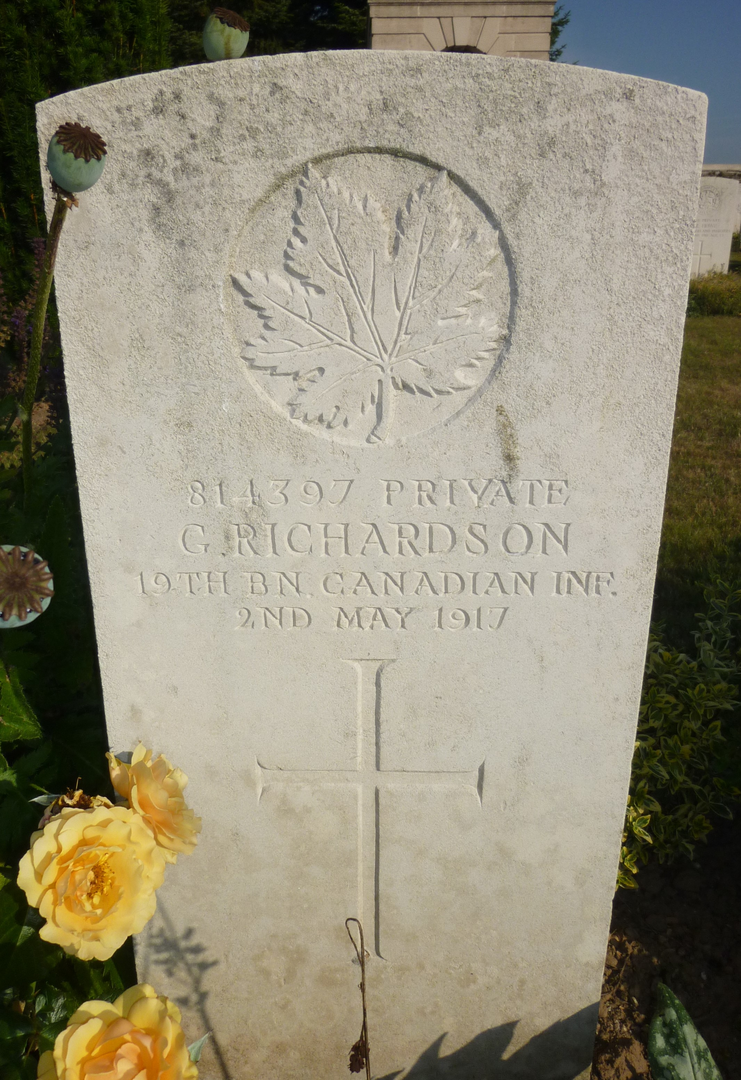
Charles (1890-1946) had already joined the Royal Navy by the 1911 census. National Archives records show he was a farm boy born in Munham Norfolk, that he joined the Navy in 1907 and that he was paid a war gratuity and discharged in 1919. In the 1939 Register he was single and living with his (retired) father, “Nr Ship Inn, Deben R.D., Suffolk, England” and working as a farm labourer. Deben District was created in 1934 after districts such as Plomesgate were disbanded. Charles died in 1946 three years prior to his father.
William (1892- ) emigrated to Canada in April 1912, marrying Bessie Millward in Brock, Ontario in 1923. The couple visited his father in 1920-1921 and settled in Blackwater, Ontario, but according to a 2010 article at least one son returned to live in England.
Not much is known about Jane (b. 1895) or Arthur (b. 1897) though Arthur was the beneficiary when probate was granted on his father’s estate in 1949. It is thought that Arthur spent at least some time in Canada in his early years. Thomas (1900 - 1901) died as an infant.
Robert (1903-98) married Bessie Watling in Blything, Suffolk before emigrating to Canada in 1926 and settling in Cresswell (near Oakwood), Ontario. There is a grave for Robert and Bessie Richardson in Durham, Ontario showing that the couple died in 1998 and 1992 respectively.
Elizabeth (1907-33) stayed in England marrying Percy Shemmings (1903-1934) in 1928 but both died very young. They had a son, Robert, in 1931, and he had no children.
In addition to the immediate family, there are many other relatives still living in the area where Benjamin grew up. Benjamin senior had a brother William who married Mary Ling and they had 8 children, first cousins to our soldier. Benjamin’s mother, Emma Farrow, had 12 siblings and there are many descendants on this line as well.
The best hope for finding a DNA match for Benjamin should most likely lie with descendants of William, Robert, or Arthur. However, we also acknowledge that it is possible - like many of the 1335 missing - that Benjamin is not at Pheasant Wood but instead may be one of the other unidentified soldiers buried or memorialised at nearby cemeteries. We aim to do our best to find his last resting place.
You Can Help – some donors have come forward but results have not yet been reviewed by the Panel/Board. A second Y DNA donor is needed with family connections to
| Soldier | Benjamin Arthur RICHARDSON 1893-1916 |
| Parents | Benjamin RICHARDSON 1863-1949 and Emma FARROW 1863-1932 (one of eight sisters) Both from Blaxhall, Suffolk | ||
| Siblings | 8 Siblings – 4 in Canada, George, Charles, William, Jane, Arthur, Thomas, Elizabeth and Robert | ||
| --- | --- | --- | --- |
| Grandparents | |||
| Paternal | Benjamin RICHARDSON 1831-1866 and Mary Anne BARNARD 1828-1913 from Suffolk | ||
| Maternal | John FARROW 1839–1899 and Anne COOPER 1838-1914 from Suffolk |
In the search on the maternal line, the family name Buckingham is sort.
Links to Official Records
Seeking DNA Donors

Contacts
(Contact: royce@fromelles.info or geoffrey@fromelles.info).
(Contact: army.uwc@defence.gov.au or phone 1800 019 090).
Donations
If you are able, please contribute to the upkeep of this resource.
(Contact: bill@fromelles.info ).
